It’s tough being a new car brand in 2024. For the longest time, the market was dominated by national carmakers alongside established names from Germany and Japan, with bit players like the Koreans and the French fighting for scraps. Just ten years ago, any suggestion that Chinese cars would register anything more than a blip on the local vehicle sales charts would’ve gotten you laughed out the room.
But when Proton started selling Geely-based products in late 2018, the penny dropped. Suddenly the public was getting comfortable with buying handsome, well made and (relatively) affordable cars from the Middle Kingdom. Fast forward to today and you have a wealth of mostly SUV options from China from the likes of BYD and Chery, both of which are reporting strong sales.
Success, however, breeds familiarity – and with it, contempt. Almost every car you see on the road right now is a middling family crossover with either a small turbocharged engine or an electric motor, many of which come from China. And that’s before sales of budding brands like GAC or MG have truly taken hold. You start to see how difficult it would be for any new brand to stand out.
Enter Jaecoo, a new brand developed by Chery. This upstart young marque is positioning itself as a more upmarket and rugged alternative to its parent company – think of it as Land Rover for the masses. Its new J7, set to reach customers’ hands in the third quarter of the year, is being touted for its off-road capabilities – rare in this day and age. But do its claims actually hold water? We wade through some of that water (and plenty more besides) at the Malaysia 4WD Training and Experience Centre (M4TREC) to find out.
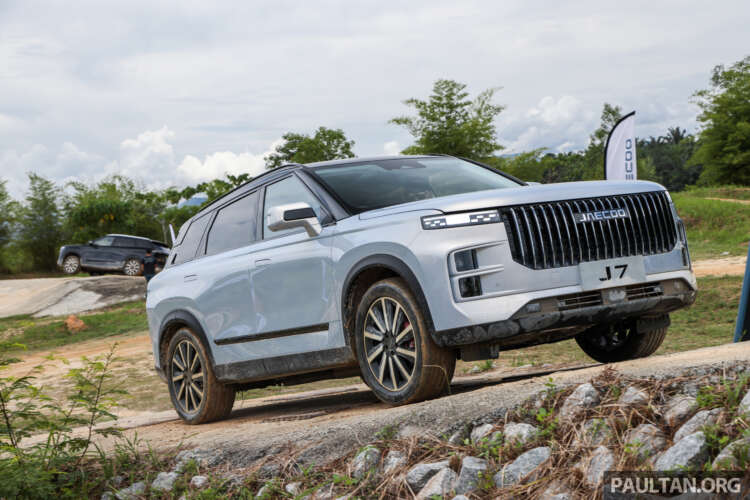
If the M4TREC acronym sounds familiar, that’s probably because this 4×4 proving ground in Semenyih is the same one used by Jaecoo to test out the J7’s go-anywhere abilities. There are huge mounds to test axle articulation, roller ramps designed to break traction and stump subpar all-wheel-drive systems, and of course, plenty of hills that can beach your car if you’re not careful.
Truth be told, the obstacles – while certainly impressive looking – can be easily cleared by any 4×4 or pick-up truck worth its salt. But the J7 is neither of these things, because while the blocky design carries shades of cut-price Range Rover, strip it to its core components and you’ll realise it’s just a regular SUV.
Here, you won’t find a low-range gearbox, locking differentials, air suspension or even all-terrain tyres. And while the J7 is available with all-wheel drive, it’s a full-time system aimed more at increasing traction in slippery conditions rather than for serious off-road use.
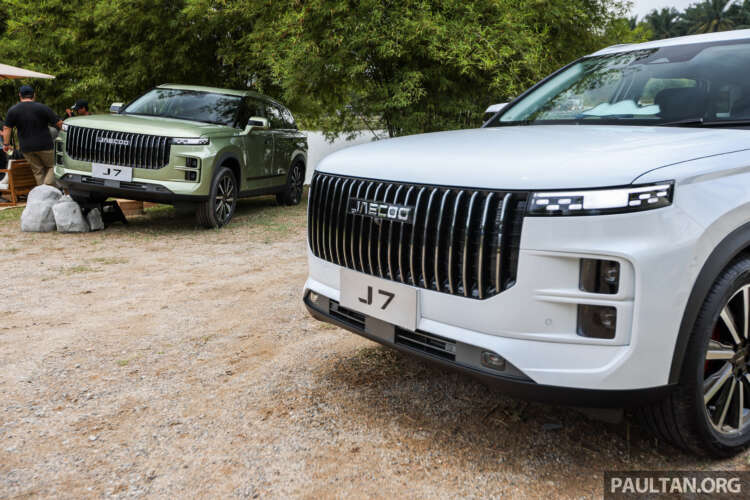
In fact, the J7 shares its platform and much of its underlying hardware with the Chery Tiggo 7 Pro. This includes the 197 PS/290 Nm 1.6 litre turbo four-cylinder petrol engine, the seven-speed wet dual-clutch transmission and even the eight-speaker Sony sound system. That’s worrying, because while the (admittedly front-wheel drive only) Chery is tipped to start at under RM130,000, Jaecoo is asking somewhere around RM160,000 for the range-topping J7 AWD.
But the J7 is not quite a Tiggo 7 Pro wearing cargo pants and an Garmin smartwatch. It’s actually much more closely related to the China-only Chery Explore 06, albeit with a much less showy waterfall grille. That means you get the same chequered-flag daytime running lights and taillights, contrasting gloss black L-shaped D-pillars and flush pop-out door handles, the beautifully damped action of which shames many supposedly premium brands.
Inside, the J7 sports a curious mix of Land Rover (chunky silvery door handles, tall and wide centre console, Jaecoo steering wheel strip) and Volvo (vertical corner air vents with rotary open/close dials) design cues. Derivative it may be, but everything feels solidly well-built and is largely covered in soft-touch materials – even if one or two iffy hard plastic panels still remain.
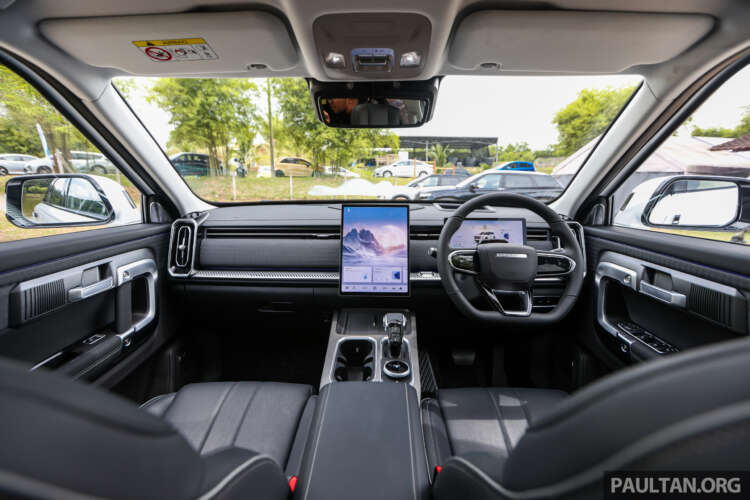
The tech also appears to be fairly agreeable, consisting of a 10.25-inch instrument display, a massive 14.8-inch “floating” portrait touchscreen and a head-up display. We had limited time with the car, but from what little we could play with it, the infotainment system works reasonably well but still lacks the last degree of polish. In particular, the drive mode being spoken aloud as you change it has a whiff of cheap Bluetooth speaker to it (“Sand mode!”). But hey, at least Apple CarPlay and Android Auto are standard, right?
But none of those things matter here. Look instead at the tweaks Jaecoo has made to ensure the J7 can go a bit further on the rough stuff. Yes, it may have Tiggo 7 Pro underpinnings, but it comes with an additional 25 mm of ground clearance. Okay, so at 200 mm it’s still not exactly Borneo Safari worthy, but it does have an impressive maximum water wading depth of 600 mm. That’s Land Rover Discovery Sport territory.
The J7 also comes with seven drive modes, three of which are for off-road use and are exclusive to the AWD version – Snow, Mud, Sand and a general Off-Road setting. Approach and departure angles are 21 and 29 degrees respectively, which are decent but not especially noteworthy. Blame the front chin spoiler for that.
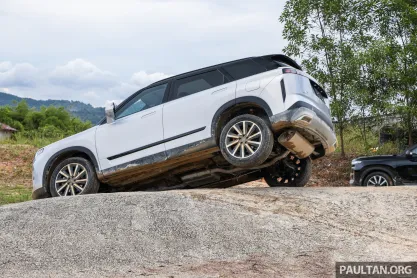
To test out the J7’s off-roader chops, Jaecoo has devised an obstacle course that includes the aforementioned roller ramps, twisting undulations and even a side slope to see how well the J7 can keep its footing, plus a fairly benign water-wading section. A second, more challenging course, reserved for the driving instructors, takes the car over the horseshoe-shaped side slope and into a deeper body of water.
Right from the get-go, the J7 feels remarkably comfortable even over rough ground, exhibiting none of the head-tossing side-to-side motion you usually get in more agricultural 4x4s and pick-ups. This bodes extremely well for its on-road ride – an area that, to be fair, Chinese carmakers typically excel at.
Much of the legwork throughout the course is being carried out by the J7’s stability control. Driver aids have become hugely sophisticated over the last decade and are now able to simulate torque vectoring by braking the wheel with the least traction. This, together with the AWD system’s ability to shuffle torque fore and aft (in as little as 0.1 seconds, Jaecoo claims), helps ensure unhindered progress when the going gets tough.
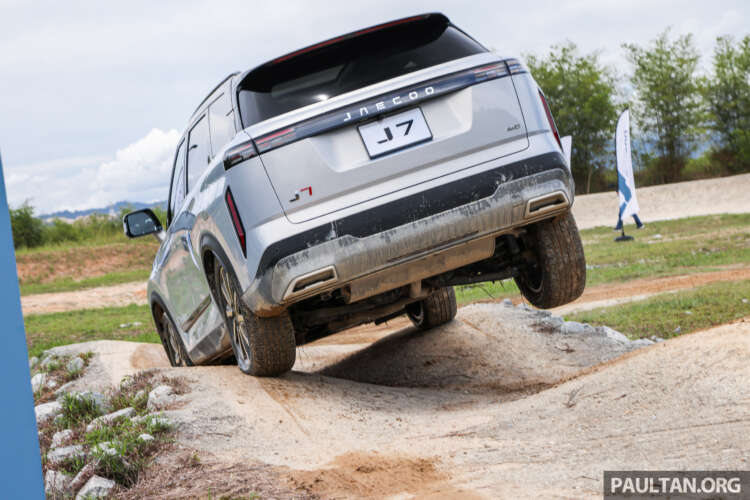
You can hear the ABS working furiously throughout this course, and to good effect. Even when stopped on a hill with three of its four tyres on rollers, the J7 is able to engage the front left wheel alone, which – after a brief scrabble to find purchase – pulls the whole car upwards on its own.
Over the large mounds, which send the J7 see-sawing and putting two wheels up in the air for dramatic effect, the car remains unfazed. Its punchy turbo engine comes into its own here – circa-200 hp doesn’t sound like much for an SUV these days, but its torque figure is among the highest in the segment, allowing the Jaecoo to get out of any situation simply by gently squeezing the throttle.
But it’s when the instructors take over that the J7 starts to show off, clambering over the horseshoe hill without so much as a scrape from the underfloor. It then proceeds to dive headfirst into a pool of water that almost completely covers the low-mounted headlights, taking it completely in its stride – no stuttering, no smoke from the back.
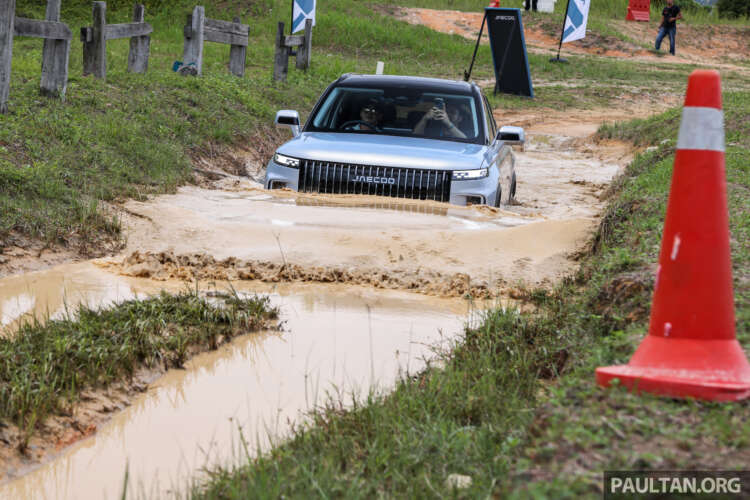
Overall, I am impressed by the J7’s abilities. More than anything, its performance shows that modern all-wheel-drive crossovers are more capable off-road than we give them credit for, and they can do much more than simply cross a muddy field. Some are more capable than others, however, and the Jaecoo sits somewhere near the top of its class in this respect.
What stood out during the experience was just how civilised and comfortable the J7 was throughout. More than one person noted that sitting in the car felt completely uneventful compared to how dramatic some of the sequences looked on the outside. It felt that way behind the wheel, too – there was very little kickback even when the car was being tipped sideways.
Negatives? Well, the electronic gear selector needs a bit of work. It has a sequential manual mode (which the instructor recommended for off-road driving), but you can’t simply knock the gearlever to the side to engage it – instead, you need to press an M button, then row the lever forwards and backwards to change gear.
You can see the problem with this system already. When you invariably need to make a three-point turn in a tight off-road course, you can’t just push the stick forwards to engage reverse – you have to press the M button first to go back to the R-N-D layout. There are also no paddle shifters on this car, which isn’t great on this RM160,000 car.
As you can imagine, this caused a bit of an annoyance during our time with the car, and even the instructor said it was a frustration for him. He added that the J7 could also use just a bit more ground clearance, but other than that, he had no complaints.
Ultimately, the Jaecoo J7’s off-road performance is largely academic, because the vast majority of buyers aren’t going to take it off the tarmac (I mean, most Land Rovers never tackle any sort of challenging terrain unless it’s climbing kerbs on Jalan Telawi).
But the brand’s outdoorsy bent does set it apart from its rivals – something the company surely hopes will translate into extra sales. We’ll just have to wait and see how it performs on the road.